
Dorner Mfg. Corp.
24
851-899 Rev. A
FlexMove FC (105 mm) Conveyor System
Installation
10. Install spacer, washer, and key onto drive shaft.
11. Install drive package
to drive motor
mounting bracket
using four socket
head screws
.
Figure 71
Figure 71
12. Install and tighten flat head screw
onto the drive shaft.
Figure 72
Figure 72
Install Guiding
All guiding must be located and installed by the end user.
Length Adjustment of the Conveyor Chain
End Drive Units and Catenary Drive Units
1. The conveyor chain is carried out at the drive end of the
conveyor.
2. The transmission guard cover must be removed from the
drive unit and the slip clutch disengaged or transmission
chain removed. The conveyor chain should now be free
to travel within the conveyor beam profile.
3. Catenary protection plates should also be removed to
allow easy access for the conveyor chain pin insertion
tool.
4. The conveyor chain should be tensioned within the
conveyor system by pulling down the conveyor chain at
the chain catenary on the underside of the drive unit.
Clamp across the conveyor chain to trap the chain on to
the beam profile. The clamp should be placed over the
edges of the drive unit to reduce the risk of damage to
the aluminum profile.
5. Remove all slack links from the conveyor chain using
the pin insertion tool.
6. Rejoin the conveyor chain using a new steel pin and
plastic pivot.
7. Remove the chain clamp and replace the catenary
protection plate and transmission chain. The slip clutch
should also be reset.
8. Replace the transmission guard cover. The conveyor is
now ready for operation.
Intermediate Drive Units and Horizontal Bend Drive
Unit
1. Conveyors which have no conveyor chain slack should
be assembled with a special section of conveyor beam
(FCCC), which allows for the chain to be easily inserted
and adjusted for tension. (See “Chain Assembly at
Chain Disconnecting Module FCCC” on page 21.)
2. Remove the lower part of this conveyor beam section by
releasing the four screws.
3. Lift the chain from this section of the beam and clamp
the conveyor chain as described above. Adjust the chain
tension as for end and catenary drive units.
In a wheel bend drive, the outer aluminum profile can be
removed by loosening the set screws in the beam connecting
strips. The slide rail must be fitted to allow the removal of
this section.
1. After removal of the outer aluminum profile, the
conveyor chain can be pulled out of the wheel bend disc.
Lift the chain upwards.
2. Remove chain links using the pin insertion tool.
3. New steel pins and plastic pivots must be used when
rejoining chain ends.
4. The tensioned chain can now be pulled back into
position on the bend guide disc, and the outer profile put
into place.
Guide Rail System Installation
Guide rails are used to guide products being conveyed, but
also to prevent them from falling off the conveyor. Guide
rails are supported by guide rail brackets attached to the
sides of the conveyor beam. Follow the mounting
instructions for the type of bracket used in your application.
Brackets should be placed approximately 500 to 1000 mm
apart depending on type of product and if accumulation
occurs or not. If brackets are spaced at greater distances than
1000 mm, there is a possibility that guide rails will become
deformed due to excessive force.
1
3
2
1















































